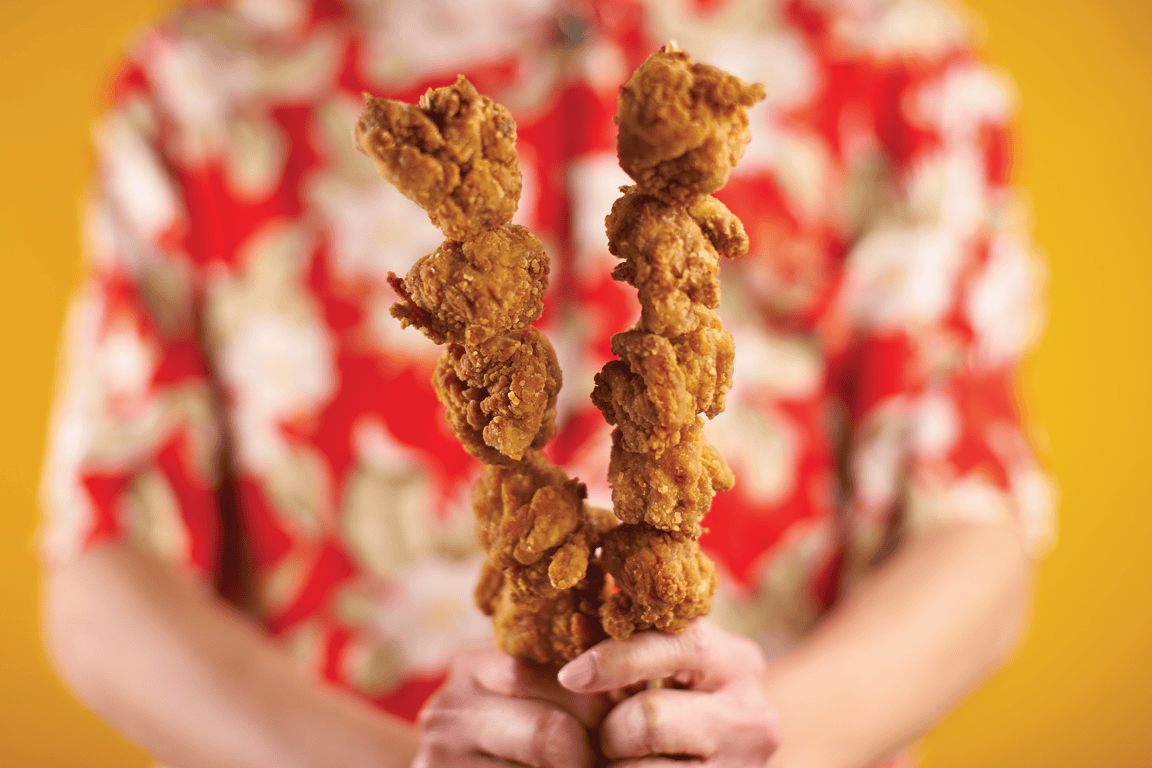
Homing in on Hawaii
The islands’ iconic food culture expands its reach across the mainland
Homing in on Hawaii
The islands’ iconic food culture expands its reach across the mainland
By Katie Ayoub
February 7, 2024
By Katie Ayoub
February 7, 2024
In recent years, many of the vibrant flavors and distinctive dishes of Hawaii have subtly found their way onto mainstream menus, acting as a postcard of tropical escape and hinting at broader possibilities. Now, the rich narrative of the state’s cuisine is coming into sharper focus on the mainland, with Hawaii-inspired fare firmly establishing itself in the national culinary landscape.
The expansion of Hawaii-born concepts across the country is building familiarity and driving interest. Hello Hilo is a new fast casual in Gainesville, Ga., developed by the Taira family, who opened a bakery in Hilo on Hawaii’s Big Island in 1950, leading to the creation of the King’s Hawaiian brand. Hello Hilo is an all-day eatery, serving up craveable, approachable modern fare with vivid ties to Hawaii’s food culture. For example, the Huli Huli Bowl features grilled chicken, teriyaki, avocado, lomi tomato (a nod to Hawaii’s lomi-lomi salmon dish), tropical fruit salsa, seasoned rice, cilantro, scallion and sesame seeds.
Holey Grail, based in Kauai and with two locations in Southern California, is introducing diners to taro-based donuts layered with Hawaii-inspired accents like black lava salt, brûléed banana and lilikoi (passionfruit). The rapid growth of Kansas City, Mo.-based fast casual Hawaiian Bros Island Grill, founded in 2018, speaks to the burgeoning popularity of the islands’ food culture, increasing from nine locations in 2020 to 51 in 2023. Its menu revolves around Hawaii’s iconic plate lunch, a cherished culinary tradition characterized by a hearty combination of rice, macaroni salad and an entrée of chicken katsu, teriyaki beef or kalua pork.
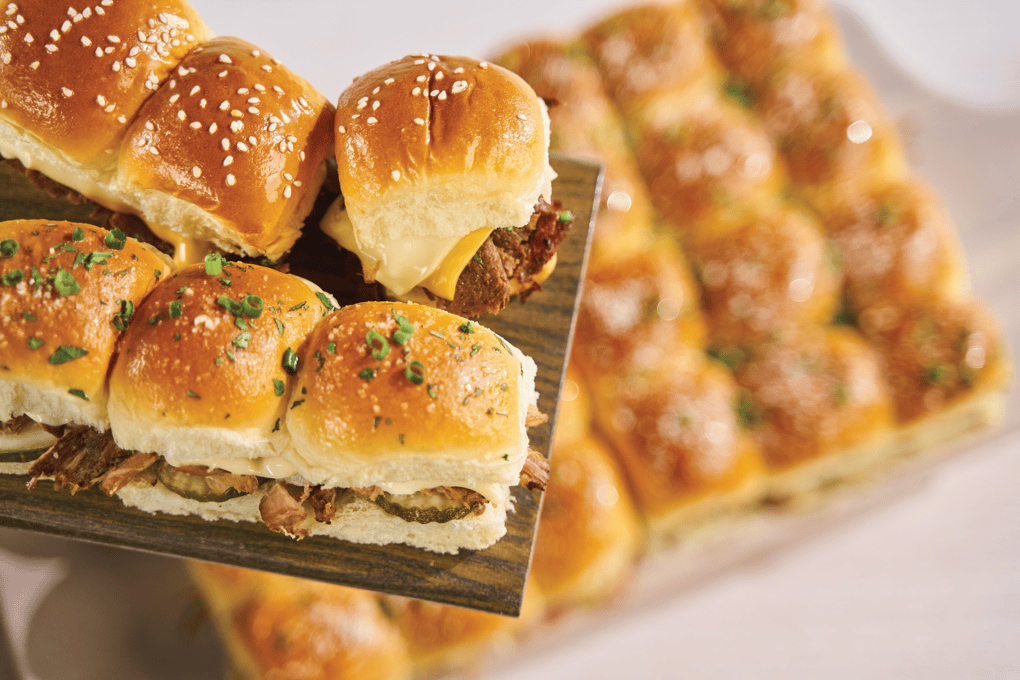 Photo Credit: Hello Hilo
Photo Credit: Hello Hilo Hello Hilo menus Kalua Pork Sliders with smoky pork, pickles, mozzarella and Swiss; served on a King’s Hawaiian roll.
While the playing field for flavor innovation is promising, a mindful approach is called for. First, it’s important to understand all that defines Hawaiian cuisine. “At Hello Hilo, we are very careful to say that our menu is Hawaii-inspired instead of calling it Hawaiian,” says Courtney Taira, chief culinary officer and brand advisor. “Calling it Hawaiian means that it’s a native recipe, developed by people who have Hawaiian blood. That includes poi, lomi-lomi, kalua pig and poke. Hawaii-inspired food is what the local people in Hawaii eat today, which is so fantastic. It’s a real melting pot and reflection of the culture and the community, with influences from Korean, Chinese, Japanese, Filipino, Micronesian and Polynesian cuisines.”
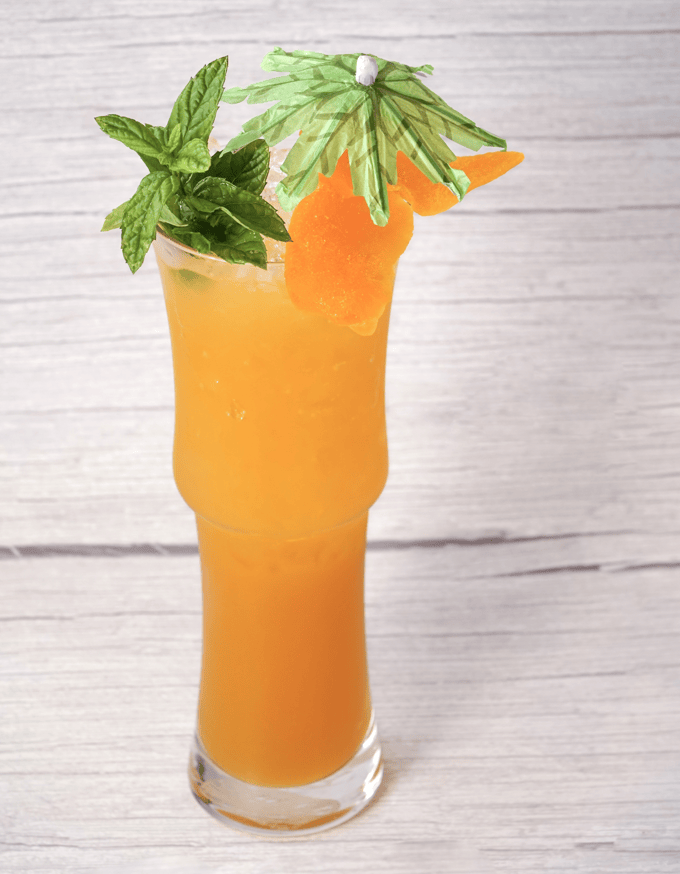 Photo Credit: Maya Alderman, Kathy Casey Food Studios
Photo Credit: Maya Alderman, Kathy Casey Food Studios San Francisco’s Tonga Room at the Fairmont Hotel serves a Tropical Itch cocktail with Hawaii-inspired flavor combinations. The drink sees a blend of Don Q 151 rum, Jamaican dark rum, Gentleman Jack, Tonga curaçao, passionfruit, mango and lime juices, and a dash of Angostura.
That’s not to say that dishes born of Hawaiian natives are off limits for flavor play. Rather, it’s a matter of framing that exploration properly. Taking the “Hawaii-influenced” or “Hawaii-inspired” approach helps ensure that cultural authenticity is respected. With these guardrails in place, the opportunity for meaningful menu exploration is significant. Hawaii’s culinary identity is rich with global mash-ups, aligning beautifully with today’s flavor preferences. And aside from a cuisine bursting with a variety of craveable, comfort-centric, bright flavor profiles, there’s a broader appeal that connects emotionally with diners. In a time when true hospitality is table stakes, consider the power of the “aloha spirit,” a Hawaiian value system that reflects a spirit of connectiveness and welcome. “The aloha spirit evokes an infectious happiness that surely is appreciated on a wide scale, with abundant ways of implementation in both menu applications and front-of-the-house service standards,” says Rob Corliss, founder of ATE (All Things Epicurean) culinary consultancy.
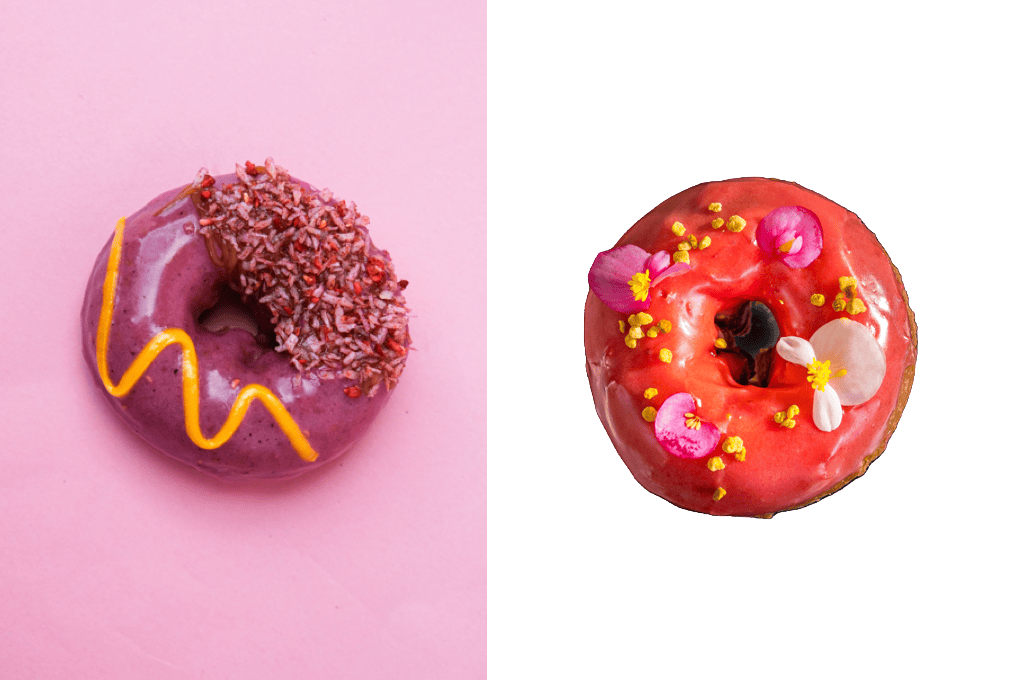 Photo Credit: Holey Grail
Photo Credit: Holey Grail Holey Grail celebrates Hawaii’s taro in its donut batter. The Rick Martinez stars raspberry, coconut, dragon fruit and tres leches (left). The Notorious P.O.G. stars passionfruit, orange and guava (right).
Tropical Vibes
Tropical flavors extend the aloha spirit, giving consumers a sense of escape with their visual appeal, freshness and sensory ties to relaxation and calm. They’re one of the greatest drivers in pushing Hawaii-inspired food onto center stage. “Tropical is always a hit with consumers,” says Mindy Armstrong, VP of menu innovation at Ascent Hospitality Management. “With every cocktail, beverage or savory menu ideation or screener that I’ve done with various brands, tropical always wins. Consumers love the freshness, the flavor, the color—all the things that come with it.”
Although there’s crossover with tropical ingredients found in the Caribbean, the Hawaiian workbench is specific to local foods and flavor combinations. Common ingredients include pineapple, coconut, lilikoi, mango, guava, lychee, taro and macadamia nuts. The flavor approach also helps define the Hawaiian tropical sensibility, pulling in culinary influences from Polynesia, Asia and the West, and using techniques like grilling and roasting.
“On the beverage side, it’s all about color and refreshing flavor, like a brilliant Dragon Fruit and Pineapple Margarita,” says Kathy Casey, owner, chef and mixologist, Kathy Casey Food Studios-Liquid Kitchen.
Hello Hilo shows off a savvy approach to tropical flavor play. Its Lilikoi Honey Mustard, menued both as an add-on and paired with the Ham & Swiss Sandwich, demonstrates a clear brand identity. On the sweet side, tropical flavor combinations are on point. Its filled Malasadas, the fluffy Hawaii-style donuts rolled in sugar, are presented in an array of island flavors, including lychee-lime, lilikoi-orange and strawberry-guava. “These combinations are signature to us, giving us a way to feature Hawaii-inspired flavors in a well-recognized format,” says Taira. The Daytrader Tiki Bar & Restaurant in Seaside, Fla., highlights tropical tones in its Sloppy Koa, with tomato-stewed Black Angus topped with grilled pineapple and Asian slaw, layered in a Hawaiian bun.
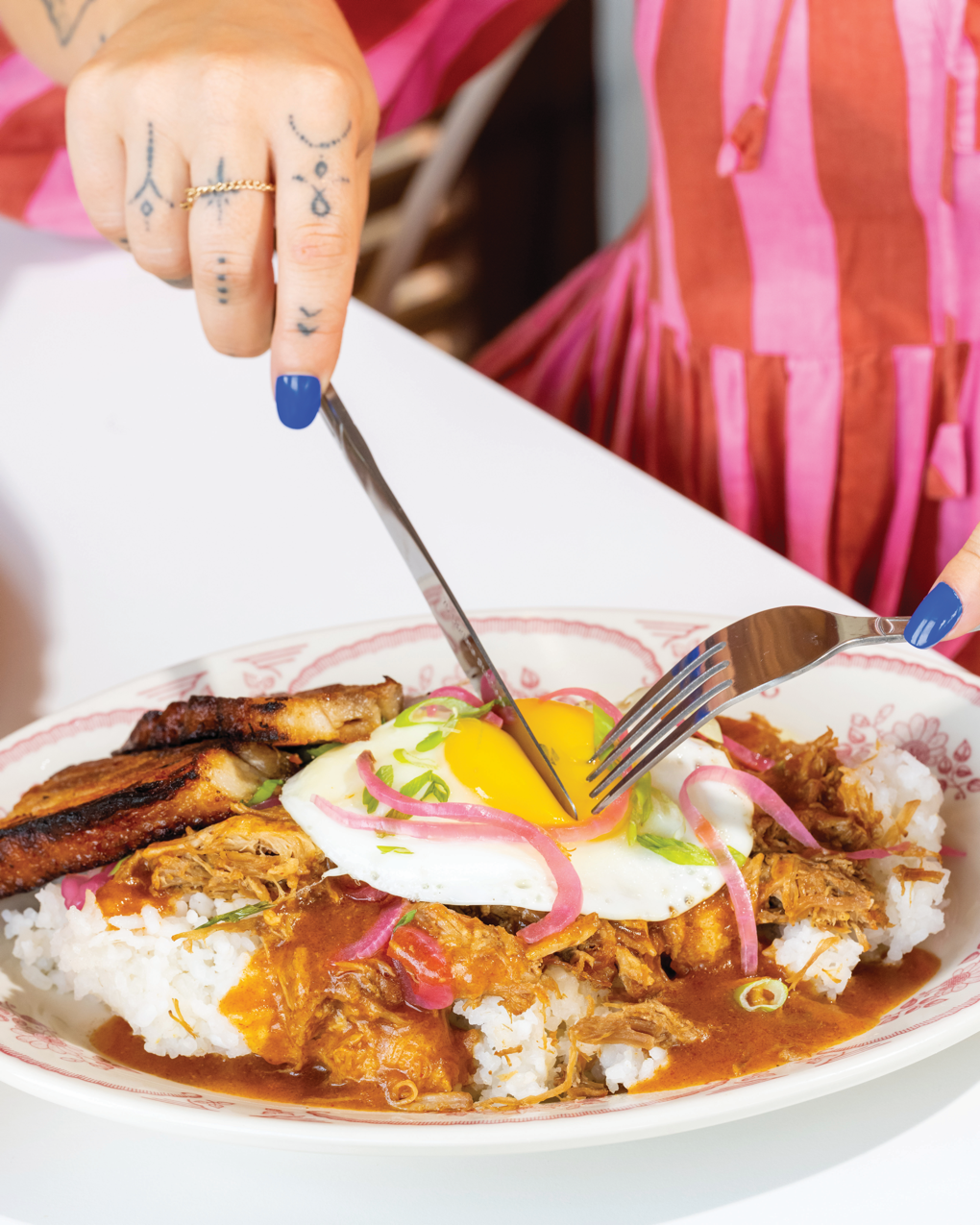 Photo Credit: The Daytrader Tiki Bar & Restaurant
Photo Credit: The Daytrader Tiki Bar & Restaurant The Daytrader Tiki Bar & Restaurant in Seaside, Fla., menus Pork Loco Moco with pork shoulder, pork belly, scallion, tamari brown gravy, fried rice and egg.
Meaty Ideas
Hawaiian food culture is a meat lover’s paradise, lending inspiration for meat-centric menu development. “Hawaii-inspired cuisine can be fully embraced through the traditions of barbecue, which are always well received by American diners,” says Armstrong. “Huli huli is a great entry point, as it’s super approachable and familiar while bringing something lesser known to the table.” Huli huli chicken, traditionally prepared by marinating the meat in a sweet and savory sauce before grilling, gets its distinctive profile from the cooking method, in which the chicken is turned multiple times on the grill to evenly heat and flavor the meat with the marinade, typically a combination of soy sauce, ginger, garlic, brown sugar and pineapple juice. Endlessly adaptable, huli huli chicken is showing up on mainland menus in sandwiches, loaded fries, salads and more.
Kalua pork is a native Hawaiian dish that traditionally involves the roasting of a whole pig in a pit filled with volcanic rocks heated by fire. Once the rocks are hot, the meat is wrapped in banana leaves, covered with wet leaves and soil, and left to gently roast for hours. The resulting pork is moist, succulent and smoky. “Our kalua pork is Hawaii-inspired with a modern twist,” says Taira. Hello Hilo menus Kalua Pork Sliders, calling out tender smoky pork, pickles, mozzarella and Swiss cheese. “Our diners might not be familiar with kalua pork, but they understand pulled pork, so they’re willing to give it a try.”
Americans certainly understand barbecue. “A prime example is found in the work of Louie Colburn, who grew up in Hawaii and made his mark in Denver at Ohana Island Kitchen,” says Rosalyn Darling, consulting chef/founder of Darling Culinary. “His Kalua Pork Mix Plate, featuring pork, rice, mac salad, mango-lime kale salad and fresh corn salsa, bears a resemblance to the traditional American barbecue platter, but its flavors are uniquely imbued with that distinct tropical allure.”
Loco moco is another meat-centric star with sound potential for translation. This comforting, simple dish consists of white rice, a hamburger patty, gravy and a fried egg. At The Blind Pig Kitchen + Bar, with two locations in California, the SPAM Loco Moco is served at brunch with Calrose rice, mushroom gravy, fried SPAM and a fried egg. Indeed, the Hawaiian love affair with SPAM stretches back to World War II and continues to anchor many local favorites.
One of the most comforting and familiar profiles that is making moves on menus today is teriyaki beef. A throwback flavor, it’s all at once nostalgic and novel. Pineapple Grill Texas in Hurst, Texas, demonstrates its simple yet alluring potential for modern riffs with its Teri Steak Fries topped with queso, teriyaki beef and green onions.
Hawaii-inspired cuisine offers a treasure trove of opportunity with natural affinities for today’s diner.
In recent years, many of the vibrant flavors and distinctive dishes of Hawaii have subtly found their way onto mainstream menus, acting as a postcard of tropical escape and hinting at broader possibilities. Now, the rich narrative of the state’s cuisine is coming into sharper focus on the mainland, with Hawaii-inspired fare firmly establishing itself in the national culinary landscape.
The expansion of Hawaii-born concepts across the country is building familiarity and driving interest. Hello Hilo is a new fast casual in Gainesville, Ga., developed by the Taira family, who opened a bakery in Hilo on Hawaii’s Big Island in 1950, leading to the creation of the King’s Hawaiian brand. Hello Hilo is an all-day eatery, serving up craveable, approachable modern fare with vivid ties to Hawaii’s food culture. For example, the Huli Huli Bowl features grilled chicken, teriyaki, avocado, lomi tomato (a nod to Hawaii’s lomi-lomi salmon dish), tropical fruit salsa, seasoned rice, cilantro, scallion and sesame seeds.
Holey Grail, based in Kauai and with two locations in Southern California, is introducing diners to taro-based donuts layered with Hawaii-inspired accents like black lava salt, brûléed banana and lilikoi (passionfruit). The rapid growth of Kansas City, Mo.-based fast casual Hawaiian Bros Island Grill, founded in 2018, speaks to the burgeoning popularity of the islands’ food culture, increasing from nine locations in 2020 to 51 in 2023. Its menu revolves around Hawaii’s iconic plate lunch, a cherished culinary tradition characterized by a hearty combination of rice, macaroni salad and an entrée of chicken katsu, teriyaki beef or kalua pork.
 Photo Credit: Hello Hilo
Photo Credit: Hello Hilo Hello Hilo menus Kalua Pork Sliders with smoky pork, pickles, mozzarella and Swiss; served on a King’s Hawaiian roll.
While the playing field for flavor innovation is promising, a mindful approach is called for. First, it’s important to understand all that defines Hawaiian cuisine. “At Hello Hilo, we are very careful to say that our menu is Hawaii-inspired instead of calling it Hawaiian,” says Courtney Taira, chief culinary officer and brand advisor. “Calling it Hawaiian means that it’s a native recipe, developed by people who have Hawaiian blood. That includes poi, lomi-lomi, kalua pig and poke. Hawaii-inspired food is what the local people in Hawaii eat today, which is so fantastic. It’s a real melting pot and reflection of the culture and the community, with influences from Korean, Chinese, Japanese, Filipino, Micronesian and Polynesian cuisines.”
 Photo Credit: Maya Alderman, Kathy Casey Food Studios
Photo Credit: Maya Alderman, Kathy Casey Food Studios San Francisco’s Tonga Room at the Fairmont Hotel serves a Tropical Itch cocktail with Hawaii-inspired flavor combinations. The drink sees a blend of Don Q 151 rum, Jamaican dark rum, Gentleman Jack, Tonga curaçao, passionfruit, mango and lime juices, and a dash of Angostura.
That’s not to say that dishes born of Hawaiian natives are off limits for flavor play. Rather, it’s a matter of framing that exploration properly. Taking the “Hawaii-influenced” or “Hawaii-inspired” approach helps ensure that cultural authenticity is respected. With these guardrails in place, the opportunity for meaningful menu exploration is significant. Hawaii’s culinary identity is rich with global mash-ups, aligning beautifully with today’s flavor preferences. And aside from a cuisine bursting with a variety of craveable, comfort-centric, bright flavor profiles, there’s a broader appeal that connects emotionally with diners. In a time when true hospitality is table stakes, consider the power of the “aloha spirit,” a Hawaiian value system that reflects a spirit of connectiveness and welcome. “The aloha spirit evokes an infectious happiness that surely is appreciated on a wide scale, with abundant ways of implementation in both menu applications and front-of-the-house service standards,” says Rob Corliss, founder of ATE (All Things Epicurean) culinary consultancy.
 Photo Credit: Holey Grail
Photo Credit: Holey Grail Holey Grail celebrates Hawaii’s taro in its donut batter. The Rick Martinez stars raspberry, coconut, dragon fruit and tres leches (left). The Notorious P.O.G. stars passionfruit, orange and guava (right).
Tropical Vibes
Tropical flavors extend the aloha spirit, giving consumers a sense of escape with their visual appeal, freshness and sensory ties to relaxation and calm. They’re one of the greatest drivers in pushing Hawaii-inspired food onto center stage. “Tropical is always a hit with consumers,” says Mindy Armstrong, VP of menu innovation at Ascent Hospitality Management. “With every cocktail, beverage or savory menu ideation or screener that I’ve done with various brands, tropical always wins. Consumers love the freshness, the flavor, the color—all the things that come with it.”
Although there’s crossover with tropical ingredients found in the Caribbean, the Hawaiian workbench is specific to local foods and flavor combinations. Common ingredients include pineapple, coconut, lilikoi, mango, guava, lychee, taro and macadamia nuts. The flavor approach also helps define the Hawaiian tropical sensibility, pulling in culinary influences from Polynesia, Asia and the West, and using techniques like grilling and roasting.
“On the beverage side, it’s all about color and refreshing flavor, like a brilliant Dragon Fruit and Pineapple Margarita,” says Kathy Casey, owner, chef and mixologist, Kathy Casey Food Studios-Liquid Kitchen.
Hello Hilo shows off a savvy approach to tropical flavor play. Its Lilikoi Honey Mustard, menued both as an add-on and paired with the Ham & Swiss Sandwich, demonstrates a clear brand identity. On the sweet side, tropical flavor combinations are on point. Its filled Malasadas, the fluffy Hawaii-style donuts rolled in sugar, are presented in an array of island flavors, including lychee-lime, lilikoi-orange and strawberry-guava. “These combinations are signature to us, giving us a way to feature Hawaii-inspired flavors in a well-recognized format,” says Taira. The Daytrader Tiki Bar & Restaurant in Seaside, Fla., highlights tropical tones in its Sloppy Koa, with tomato-stewed Black Angus topped with grilled pineapple and Asian slaw, layered in a Hawaiian bun.
 Photo Credit: The Daytrader Tiki Bar & Restaurant
Photo Credit: The Daytrader Tiki Bar & Restaurant The Daytrader Tiki Bar & Restaurant in Seaside, Fla., menus Pork Loco Moco with pork shoulder, pork belly, scallion, tamari brown gravy, fried rice and egg.
Meaty Ideas
Hawaiian food culture is a meat lover’s paradise, lending inspiration for meat-centric menu development. “Hawaii-inspired cuisine can be fully embraced through the traditions of barbecue, which are always well received by American diners,” says Armstrong. “Huli huli is a great entry point, as it’s super approachable and familiar while bringing something lesser known to the table.” Huli huli chicken, traditionally prepared by marinating the meat in a sweet and savory sauce before grilling, gets its distinctive profile from the cooking method, in which the chicken is turned multiple times on the grill to evenly heat and flavor the meat with the marinade, typically a combination of soy sauce, ginger, garlic, brown sugar and pineapple juice. Endlessly adaptable, huli huli chicken is showing up on mainland menus in sandwiches, loaded fries, salads and more.
Kalua pork is a native Hawaiian dish that traditionally involves the roasting of a whole pig in a pit filled with volcanic rocks heated by fire. Once the rocks are hot, the meat is wrapped in banana leaves, covered with wet leaves and soil, and left to gently roast for hours. The resulting pork is moist, succulent and smoky. “Our kalua pork is Hawaii-inspired with a modern twist,” says Taira. Hello Hilo menus Kalua Pork Sliders, calling out tender smoky pork, pickles, mozzarella and Swiss cheese. “Our diners might not be familiar with kalua pork, but they understand pulled pork, so they’re willing to give it a try.”
Americans certainly understand barbecue. “A prime example is found in the work of Louie Colburn, who grew up in Hawaii and made his mark in Denver at Ohana Island Kitchen,” says Rosalyn Darling, consulting chef/founder of Darling Culinary. “His Kalua Pork Mix Plate, featuring pork, rice, mac salad, mango-lime kale salad and fresh corn salsa, bears a resemblance to the traditional American barbecue platter, but its flavors are uniquely imbued with that distinct tropical allure.”
Loco moco is another meat-centric star with sound potential for translation. This comforting, simple dish consists of white rice, a hamburger patty, gravy and a fried egg. At The Blind Pig Kitchen + Bar, with two locations in California, the SPAM Loco Moco is served at brunch with Calrose rice, mushroom gravy, fried SPAM and a fried egg. Indeed, the Hawaiian love affair with SPAM stretches back to World War II and continues to anchor many local favorites.
One of the most comforting and familiar profiles that is making moves on menus today is teriyaki beef. A throwback flavor, it’s all at once nostalgic and novel. Pineapple Grill Texas in Hurst, Texas, demonstrates its simple yet alluring potential for modern riffs with its Teri Steak Fries topped with queso, teriyaki beef and green onions.
Hawaii-inspired cuisine offers a treasure trove of opportunity with natural affinities for today’s diner.
About the Author
![]() Katie Ayoub serves as managing editor of Flavor & The Menu and content strategist for the Flavor Experience, an annual conference geared toward chain operators. She is president of Katie Ayoub & Associates, serving up menu trends expertise, content creation and food & beverage consultancy. Based in Chicago, Katie has been working in foodservice publishing for more than 20 years and part of the Flavor team since 2006. [email protected]
Katie Ayoub serves as managing editor of Flavor & The Menu and content strategist for the Flavor Experience, an annual conference geared toward chain operators. She is president of Katie Ayoub & Associates, serving up menu trends expertise, content creation and food & beverage consultancy. Based in Chicago, Katie has been working in foodservice publishing for more than 20 years and part of the Flavor team since 2006. [email protected]







